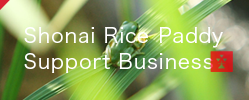Nowadays, various farming methods coexist
The farm representative’s father Seichi, inherited the farm that had been handed down from his ancestors. He cultivated rice, using the conventional farming method that was adopted by most of the farmers in the area and distributed through consignment to agricultural cooperatives. This is how he made a living. He is over 80 years old now but still a healthy and vigorous farmer.
His son Hiroshi who calls himself Yahei Itagaki the 15th, shifted from conventional to organic farming and changed the farm from sole proprietorship to a limited liability company. He took over as the representative and became a grower who cultivates and sells rice by himself. He is in his late fifties and he is the current head of the farm.
His son Keisuke has decided to establish himself as a farmer and has determined to preserve agriculture. He is in his early thirties and is an apprentice, expected to lead the next generation of this farm.
In New Year, the three generations pray together, an event wishing a rich harvest for the year. The harvest last year was quite good. It seems that his rice has been highly regarded by distributors and has been selling very well so they hope it continues this year as well. The New Year party is full of hope.
In the beginning when Hiroshi started organic farming, he was misunderstood by everyone, even by his family. He never explained it in detail but I heard that he struggled for a long time and it was a rough start. I imagine there were conflicts about his farming method and the way he sold his crops and how this was different from his father's way but this has already been settled. Now the three generations of Itagaki (Seiichi, Hiroshi and Keisuke) work together in the farm. It is admirable that the elder Itagaki allowed his son to introduce his farming method and I suppose that he will allow the next generation to farm their way.
My company is here to support this farm in cooperation with a venture company located in the local area. The 3 generations working together has inspired us to work with them and at the end of last year, we conducted the inventory of the rice stock. They have consulted us about taxes and we are planning the production, sales and distribution operation system. This is still at the early stage but we are committed in giving the support they need.
There are different methods of farming such as natural, organic and general farming. I searched online and I even found microorganism farming. When I meet an agriculturist, a farmer or someone familiar with farming, I ask them about different methods but I am not sure what is mainstream. Different people introduce different methods and these methods work for different people and it has its pros and cons. If we are fixated on one method, we might become uncompromising so we should not reject other ideas. At this point, it is best to have an open mind and consider what is the most beneficial without rejecting opposing viewpoints.
Hiroshi Itagaki understands the issues of organic agriculture. Excessive organic fertilizer can damage the soil and organic fertilizer that is derived from an animal could also have problems too though it is organic. He explained these problems to us because of his knowledge about this matter and we have high expectations of him.
Paddy fields that save energy of the soil under the snow.
I’ve read in a certain book that the thickness of the soil that covers the surface of the earth is from 30 centimeters to 1 meter. The subject is how to generate the soil. They say it takes 500 years to generate only 5 centimeters of soil as erosion and weather affect the earth, water drying, freezing and melting breaks rocks, roots of plants crack rocks and microbes decompose the plant under the ground. They say it takes between 100 to 200 years for an earthworm to make soil that is only 2.5 cm thick.
Even the soil that takes such a long time to make is eroded in time. Although soil is very precious and it should be protected, it seems we don’t take care of it. It is the base for growing plants but if it is exhausted, or if it is over fertilized, we cannot grow good crops.
A paddy field that grows 600 kilograms of rice per 10 are for 10 years where we overuse the soil and a paddy field that grows 300 kilograms of rice per are for 20 years where we protect the soil. Which is better? We really need to think about it.
Mr. Itagaki examines the soil, smells it and sometimes tastes it. He understands the condition of the soil is affected by the melting snow on the paddy fields. He believes that the water flowing from the thick forest in the upper stream adds nutrition to the soil. He knows the importance of this through his wisdom and experience. In the beginning, he probably repeated what other people said but now he knows without a doubt the importance of soil and this is what we want to write about the Shonai region.
Shonai plain in winter
The snow covers the ground and protects the soil from erosion. It is beyond human knowledge, the soil in the paddy field under the snow stores energy. It keeps the soil fertile for good rice.
This is my belief.


















